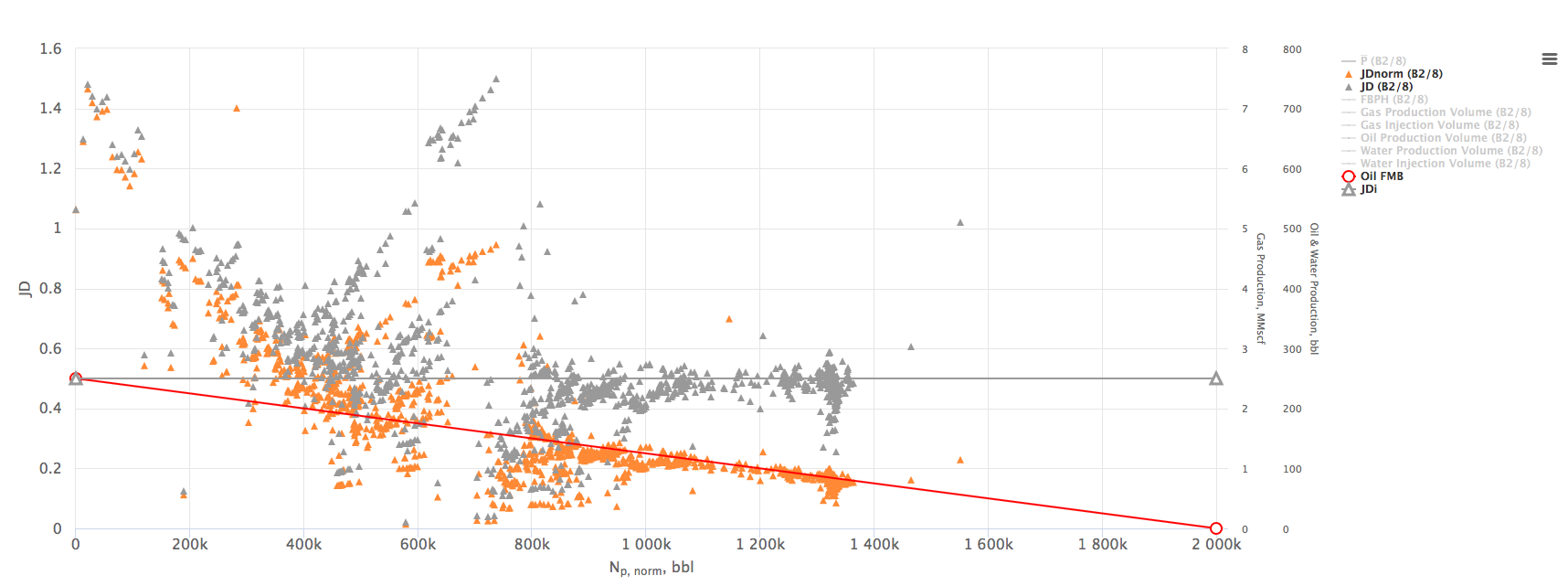Difference between revisions of "Oil Flowing Material Balance"
(→Case Study) |
(→Case Study) |
||
| Line 79: | Line 79: | ||
==Case Study== | ==Case Study== | ||
[[File:oilFMB_CaseStudy.pdf| Download Case Study (pdf)]] | [[File:oilFMB_CaseStudy.pdf| Download Case Study (pdf)]] | ||
| + | |||
[[File:well 8 daily data.csv]] | [[File:well 8 daily data.csv]] | ||
Revision as of 13:24, 18 April 2018
Contents
Brief
Oil Flowing Material Balance (Oil FMB) is the advanced engineering technique published in 2005 by Louis Mattar and David Anderson [1].
Oil Flowing Material Balance is applied to determine:
- Reservoirs STOIIP & EUR
- Well's EUR and JD
Oil Flowing Material Balance uses readily available Well flowing data: production rate and bottomhole pressure.
The interpretation technique is fitting the data points with the straight lines to estimate STOIIP and JD.
Math & Physics
The total pressure drop at the wellbore is:
Where
 , is pressure drop due to depletion defined by the Oil Material Balance
, is pressure drop due to depletion defined by the Oil Material Balance
 , is pressure drop due to Darcy's law
, is pressure drop due to Darcy's law
In terms of oil pseudo pressure the total pressure drop is:
Where
Finally, the Oil Flowing Material Balance equation:
Or
Where
Discussion
Oil Flowing Material Balance can be applied to:
- single well
- multiple wells producing from the same Reservoir.
The X axis on the Oil Flowing Material Balance Plot can be selected as:
Note what Oil Flowing Material Balance accounts for the changing PVT properties of the oil with pressure.
Workflow
- Upload the data required
- Open the Oil Flowing Material Balance tool here
- Estimate the N (red line X-axis intercept)
- Calculate the average reservoir pressure
 based on N, known production data and using Oil Material Balance equation
based on N, known production data and using Oil Material Balance equation - Calculate the

- Calculate the

- Plot the orange
 vs
vs  line:
line: - Change the N to match the orange line with the red one
- Change the gray JD line Y-axis intercept to match the changing JD
- Save the Oil Flowing Material Balance model
- Move to the next well
Case Study
Data required
- Create Field here
- Create or Upload Reservoirs here
- Input the Reservoirs GIIP and STOIIP here
- Create or Upload PVT (SG, Pi, Ti) here
- Upload Wells
- Create or Upload Wells Perforations here
- Create or Upload kh and JD here
- Upload Daily Measures
In case you need to calculate the flowing bottomhole pressure from the wellhead pressure:
- Calculate the flowing bottomhole pressures using BHP Calculator
- Export flowing bottomhole pressures to Daily Measures here
In case you want to add the static reservoir pressures on the FMB Plot:
- Create or Upload the static reservoir pressures, here
- Calculate Monthly Measures from the Daily Measures using Monthly Data Calculator
Nomenclature
 = oil formation volume factor as a function of pressure, bbl/stb
= oil formation volume factor as a function of pressure, bbl/stb = dimensionless productivity index, dimensionless
= dimensionless productivity index, dimensionless = dimensionless productivity index in terms of the oil pseudo pressure, dimensionless
= dimensionless productivity index in terms of the oil pseudo pressure, dimensionless = oil permeability times thickness, md*ft
= oil permeability times thickness, md*ft = stock tank oil initially in place, stb
= stock tank oil initially in place, stb = normalized cumulative oil production, stb
= normalized cumulative oil production, stb = pressure, psia
= pressure, psia = average reservoir pressure, psia
= average reservoir pressure, psia = initial pressure, psia
= initial pressure, psia = oil pseudo pressure, psia
= oil pseudo pressure, psia = reference pressure, psia
= reference pressure, psia = well flowing pressure, psia
= well flowing pressure, psia = oil rate, stb
= oil rate, stb
Greek symbols
 = oil viscosity as a function of pressure, cp
= oil viscosity as a function of pressure, cp
References
- ↑ 1.0 1.1 Mattar, L.; Anderson, D (2005). "Dynamic Material Balance (Oil or Gas-In-Place Without Shut-Ins)" (PDF). CIPC.
- ↑ 2.0 2.1 Stalgorova, Louis; Mattar, Ekaterina (2016). "Analytical Methods for Single-Phase Oil Flow: Accounting for Changing Liquid and Rock Properties". Society of Petroleum Engineers.









